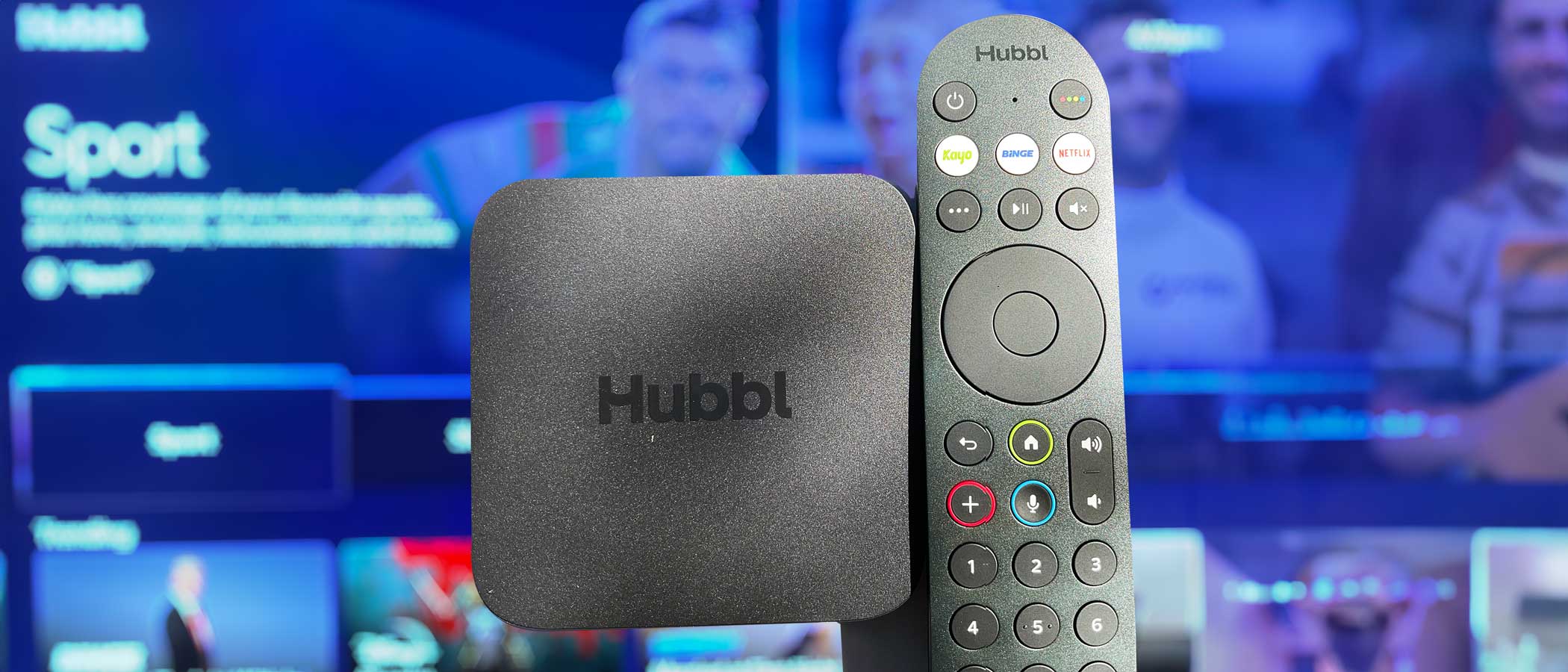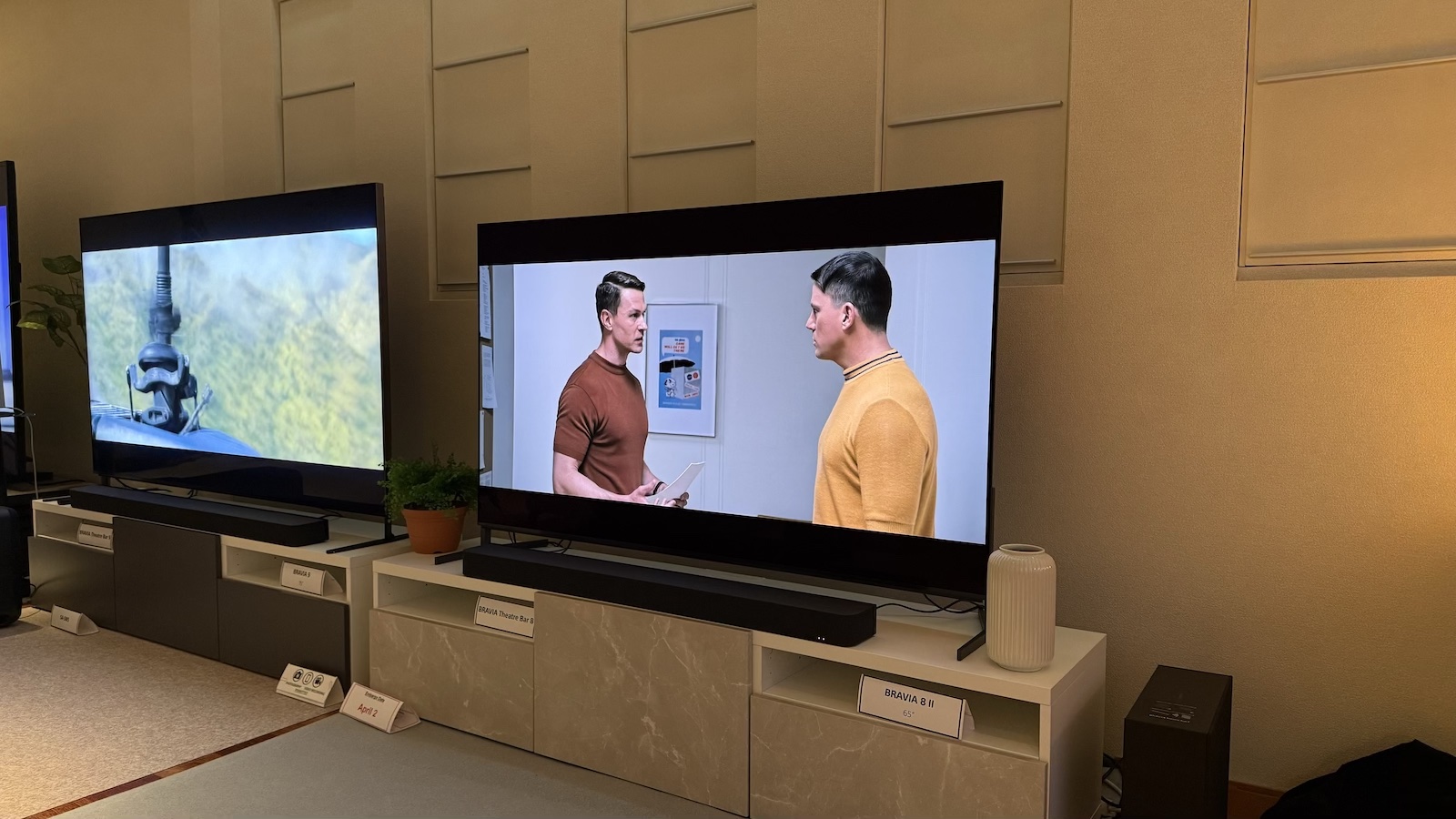Sound+Image Verdict
As it stands, the Hubbl is hard to recommend as your main device for TV streaming services, unless you’re just looking for a way to squirt your existing Binge and Kayo into a dumb TV in an extra room of the house. If you’re looking for a versatile media player, there are better options.
Pros
- +
Neat box with TV antenna input
- +
4K output with HDR
- +
'Stacking discounts' for some subscriptions
- +
Good remote
Cons
- -
Limited services available
- -
No recording from free-to-air
- -
Locked to 50Hz by default
Why you can trust What Hi-Fi?
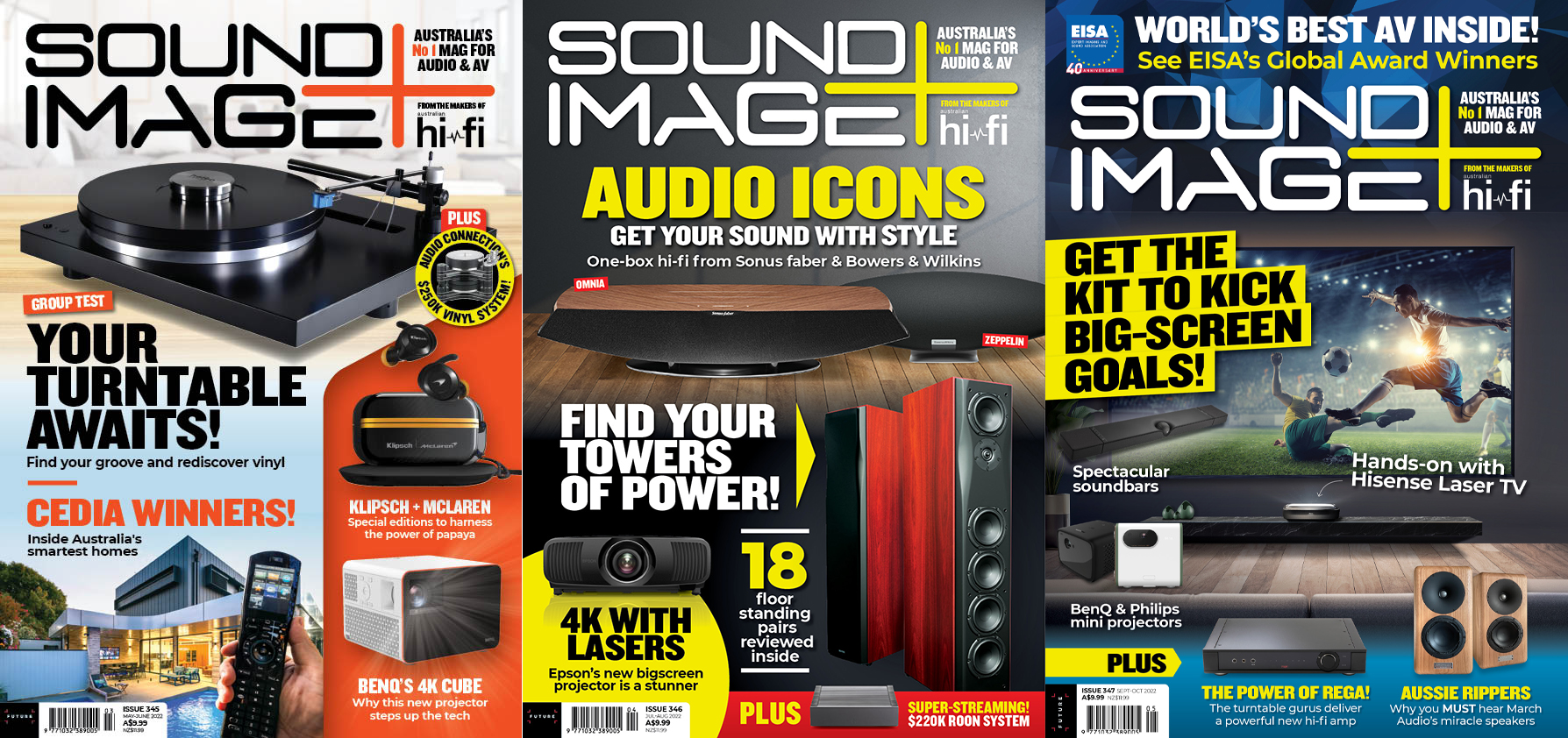
This review originally appeared in Sound+Image magazine, Australian sister publication to What Hi-Fi?. Click here for more information on Sound+Image, including digital editions and details on how you can subscribe.
So welcome Hubbl. It’s a good brand name, if NASA doesn’t object – friendly and modern, and not merely reverse-engineered from the Space Telescope, but semantically extended from its original name of 'Hub', which still appears on the booklets in the box, and on the tab of Hubbl's home page.
But the puck-like media player is now specifically called just Hubbl (or the 'Hubbl puck'), while there are also 'Hubbl Glass' TVs being released under this new brand.
It all comes from Streamotion, part of the Foxtel Group. Or more accurately, Streamotion seems to be undergoing a rebranding as Hubbl, to mark this arrival of hardware to complement what was previously a digital B2C streaming business based around its own streaming services Binge, Foxtel Now, Kayo Sports and Flash.
For those interested in ultimate ownership, the Foxtel Group is 65% owned by News Corp and 35% by Telstra. It seems an unlikely coincidence that Telstra announced that its own Telstra TV media box will no longer be available for purchase (“we plan to shut it down in 2024”, says its website), and yet Telstra is there pushing its customers over to Fetch TV, which is one of the last proper do-it-all personal video recorders remaining on the market, and a product that we heartily recommend.
But a Fetch 4K Mighty will cost you $450. The Hubbl puck is just $99. So what is it? What can it bring to your home?
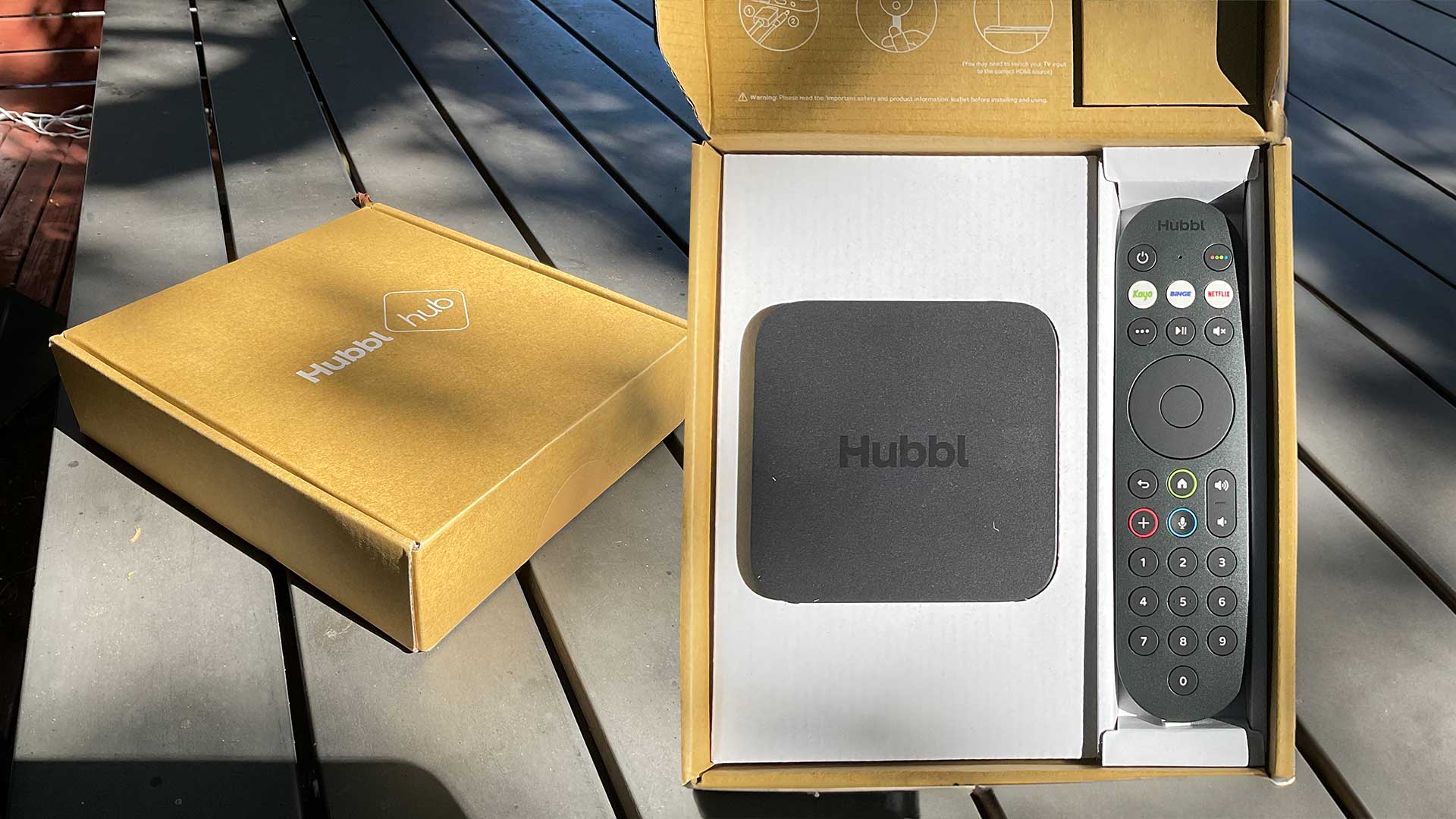
Glassy clues
A big clue to the Hubbl’s true origins comes from the simultaneous launch of the ‘Glass’ TVs, which are to be available in 42-inch, 55-inch and 65-inch sizes. Over in the UK, of course, Sky has had ‘Sky Glass’ TVs since 2021, which use panels from TP Vision (which also makes Philips TVs). Given the historical connections between Foxtel and Sky, it seems probable that the Hubbl TVs arrive via a similar path, despite Sky these days being fully owned by the US media giant Comcast.
As for the Hubbl puck, a search of Sky products in the UK shows it to greatly resemble the Sky Stream puck, a media box much vaunted by our UK What Hi-FI? colleagues, and which Sky gives away for free with every Stream account. But that’s because Sky is also a major internet and telecoms provider over there, and they capture consumers through the power of their streaming options, bundled into phone and internet contracts.
In Australia Foxtel doesn’t have that sort of leverage (though Telstra does), so the Hubbl is a box that you buy. And because it's not tied to already paid services, it's quite a different kettle of fish once in operation.
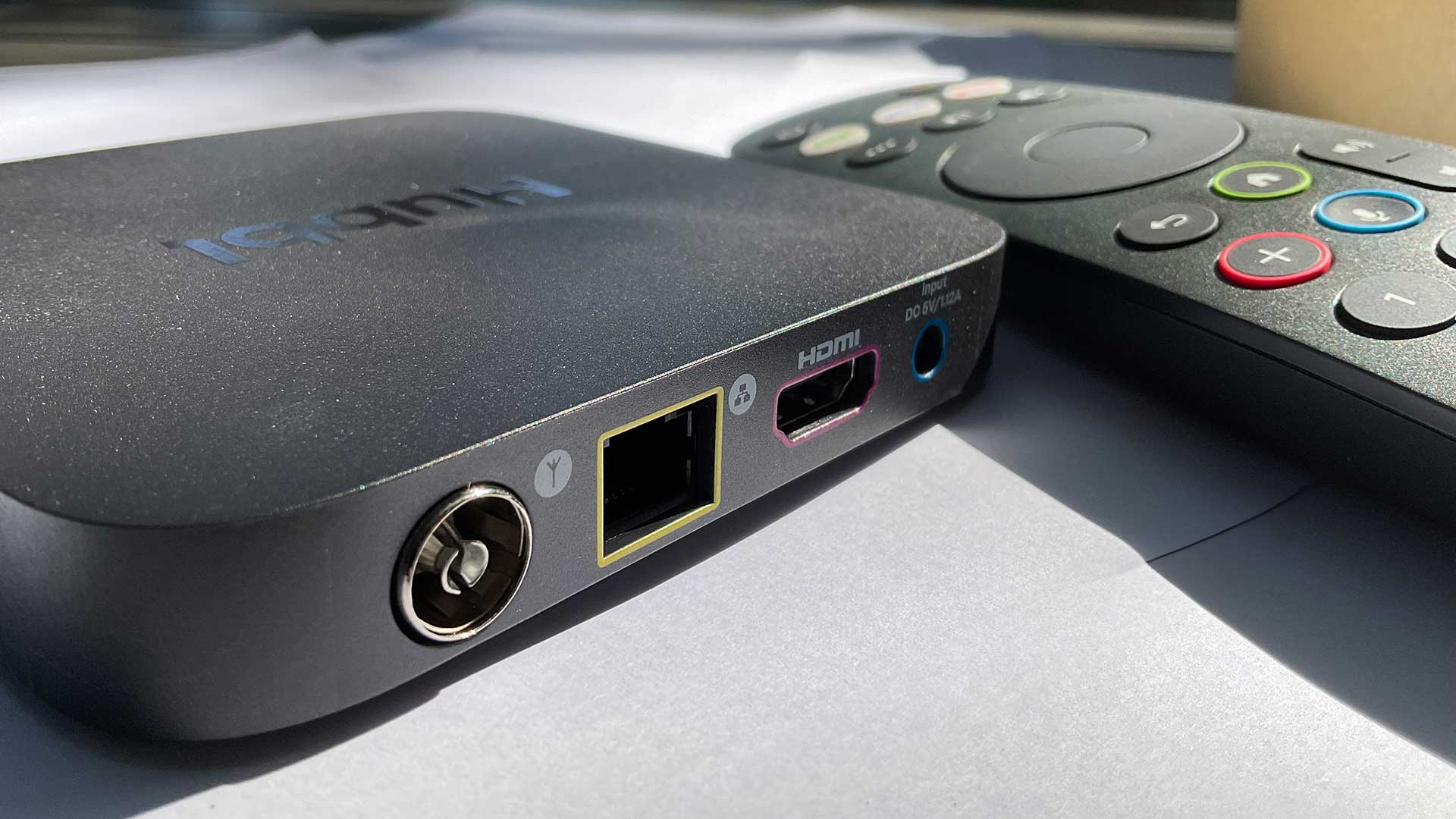
Hub connections
And it looks like a good deal. Indeed it looks – superficially, mind – very like an Apple TV media player, although more like the very first edition, back in the days when Apple still included an optical output, rather than the later and thicker Apple TV 4K boxes. But even that comparison doesn’t hold, because when we did pull out our old original Apple TV, it was the same size as the Hubbl puck give or take a few mms, but it felt rather more substantial and weighty against the Hubbl Hub’s very plastic and lightweight construction.
The rear panel is also quite different. Power in, yes; HDMI out, yes. But the Hubbl also has an antenna input – a coaxial type as well, thankfully, not a BNC twister. No antenna cable is supplied, but you do get an HDMI cable, and it’s even coloured pink at one end to match the pink-labelled socket on the back (though surely the most hamfisted consumer could match an HDMI plug to an HDMI socket).
You also get a remote control, again identical to the one which comes with a Sky Stream puck except for gaining a row of three direct access buttons for Kayo, Binge and Netflix.
Not much preparation required, then – plug it into your TV, and the mains, and power it up from a little button underneath.
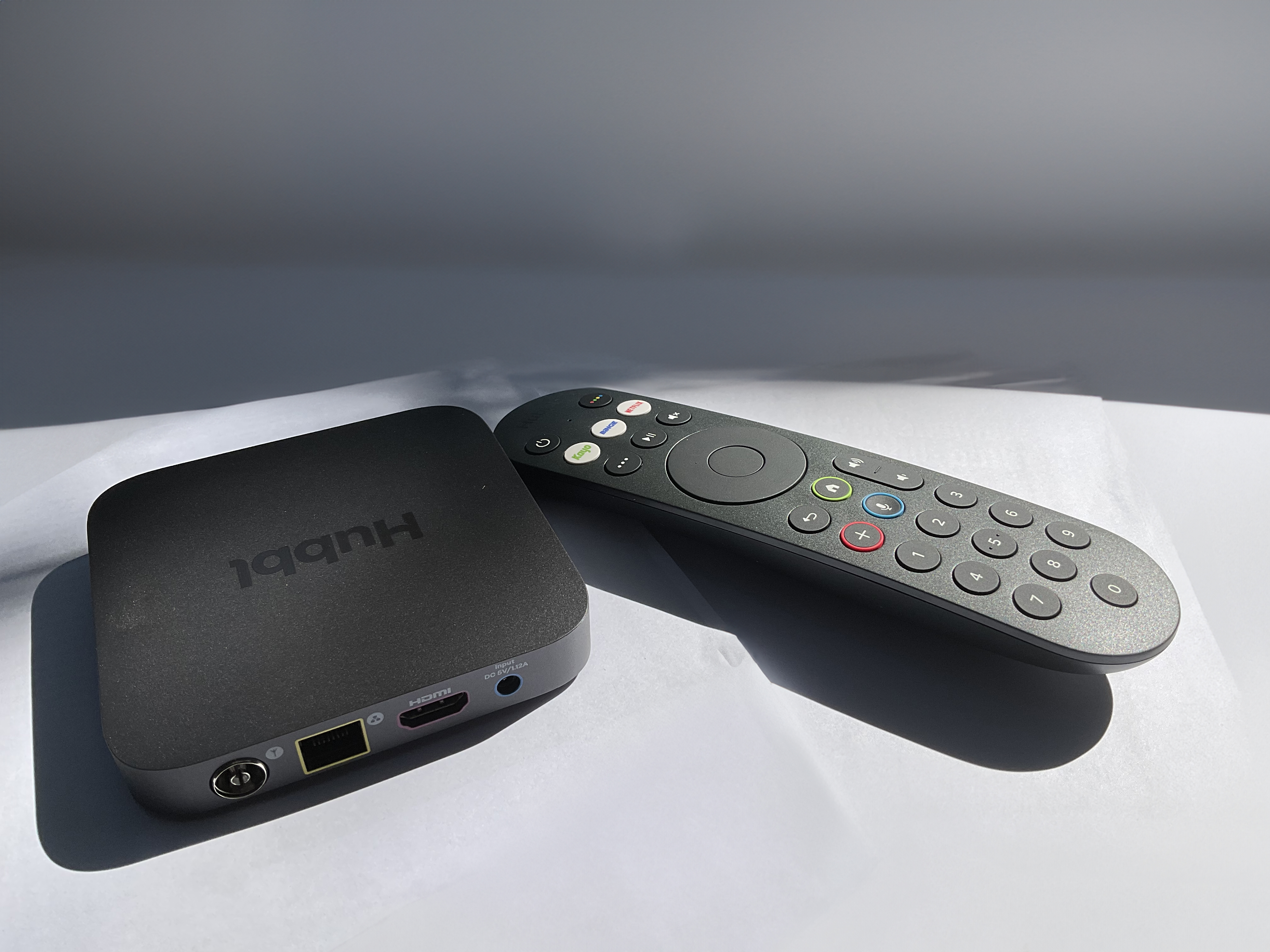
Set-up and streaming
‘Hello’, it says, very large on your screen, then gets you connected to Wi-Fi and has quite a long think while it ‘checks your status’, then updates its software – it’ll only take a moment, it says, and five minutes later we were back to the big ‘Hello’, but this time fully connected.
Except for the remote, which requires connecting even though you’re already using it (this adds RF operation, we think, so you no longer have to point it).
It knew who we were, presumably because to buy one you have to set up a Hubbl account, and somehow it knows. It used part of our phone number as a password. Makes you wonder how much it’ll know about you by the time you’ve been using it for a while…
If you attached an antenna, the Hubbl will now tune itself in. Including free-to-air TV viewing is a major inclusion, for our money, though we are fully aware that many people now solely stream, also that the free-to-air services provide streaming versions of their live channels at qualities that sometimes seem to exceed the broadcast version.
In that regard we were also delighted that the first on-screen offering made by the Hubbl during set-up is not for its own paid streaming channels but for all five free-to-air apps. Each of those is going to need an account and sign-in, but only SBS lacks a quick system and requires keyboard text entry; the others have QR codes or quick links if you already have an account. It’s great that the free content is emphasised in this way, especially as the free-to-airs have been campaigning recently for more visibility on smart TVs and the like.
Once you get to the home page, however, the free-to-air gets shoved off to the right initially, behind Binge, Netflix, Kayo Sports, Disney Plus, Amazon Prime Video, YouTube, Apple TV, LifeStyle and Flash. ABC Kids and YouTube Kids are at the far end of the row. (Talking of kids, you can put a PIN lock on pay-to-view content.) To be fair, these tiles change position according to use, but it’s fairly clear that Foxtel is not so much here to sell Hubbl boxes as to sell its streaming content. Not as ‘Foxtel’, though – there’s no Foxtel Go or Foxtel Now app here, which is so odd that we may perhaps consider it a deliberate omission, replaced by the stacking of multiple services.
Otherwise the Hubbl is clever at letting you get right to the content before you have to pay. If you go to Binge on an Apple TV media player, you can’t see what content is available until after you stump up for a subscription (which we’ve always thought was a pretty dim way to sell the service). But on the Hubbl you can browse to your heart’s content through Binge’s programming, pick something you like, and only when you press Play does it ask for money.
Actually, first it told us we couldn’t play that particular 4K show because we didn’t have a 4K TV. This was technically correct, as we were using an 8K Samsung at the time, but the Hubbl was actually warning us that it was set to output at 1080p. It led us nicely to the settings to correct this to 4K (the puck is also compatible with Dolby Vision and HDR10); the HDMI connection then reshook and we had to navigate back to our Binge program, and press Play again.
The packages
Ah, says the Hubbl – ‘You’re nearly there. Choose your preferred package.’
But it showed us only the Binge options: $10 in ‘HD’ with ads, $18 or $22 for 4K ad-free.
One of the selling points of the Hubbl Hub, however, is that you can ‘stack’ subscriptions to get a discount (that would be if you’re one of those people who follows Sound+Image’s suggested modus operandi of watching one service till you’ve drained it, then unsubscribing and watching another service, so you only ever pay for one).
For subscription addicts, stacking is a nice idea, though not wildly generous here: it applies only to Netflix and the Foxtel apps (Binge, Kayo Sports, Flash and LifeStyle), and you have to subscribe to at least three of those before stacking credits kick in. Subscribing to three eligible apps gets you $5 per month credit, four eligible apps gets you $10 per month, all five eligible apps will earn a $15 per month credit.
Of course by then you’ll be paying a minimum of $60 a month, or double that if you’re taking all the 4K options.
So it’s a saving for entertainment addicts, but that Sound+Image detox method will save you rather more.
Operation and viewing
Of course, if you’re buying this box as your sole ticket to streaming, you will want it to be able to access everything. Well it doesn’t. There’s no app store to get more, as on a Google or Android TV, or on a modern Apple TV. This is like the original AppleTV that launched back in 2007, which had a fixed set of apps that could only be supplemented by an update from Cupertino.
The most obvious omissions on the Hubbl are Stan, Paramount Plus, and Optus Sport, though Hubbl’s website marks those as ‘Coming Soon’.
[Update: August 2024 – Hubbl has now completed its 'launch partner roadmap' and has indeed added Stan, Paramount Plus and Optus Sport! These do not appear to count towards the stacking discounts.]
But there’s no BritBox, Tubi, Plex, DocPlay, History Hit; no apps for Ted, Vevo or Vimeo, Mubi, RedBull or Crunchyroll; no music apps like Spotify or Tidal. For anyone used to a relatively open system on a different media player, the Hubbl feels old-school walled garden. To be fair, this is the launch selection, and we gather that negotiations are ongoing for other services as well. But we can only just it on the current selection.
Did the provided content work well? Initially it appeared so; images were strong and clear, and when we compared the same output from different sources (AppleTV, Fetch) the picture quality stood up. It's a capable player at that level.
We quickly focused on two issues. Firstly the Hubbl puck outputs at 50 frames per second by default, regardless of the content being played. This is ironic, as we regularly criticise Android TV devices for being locked to 60Hz and so bringing judder to our local 50Hz sources. Here it’s the other way around – locked for local content, leaving all the foreign stuff to potentially judder under frame-rate conversion.
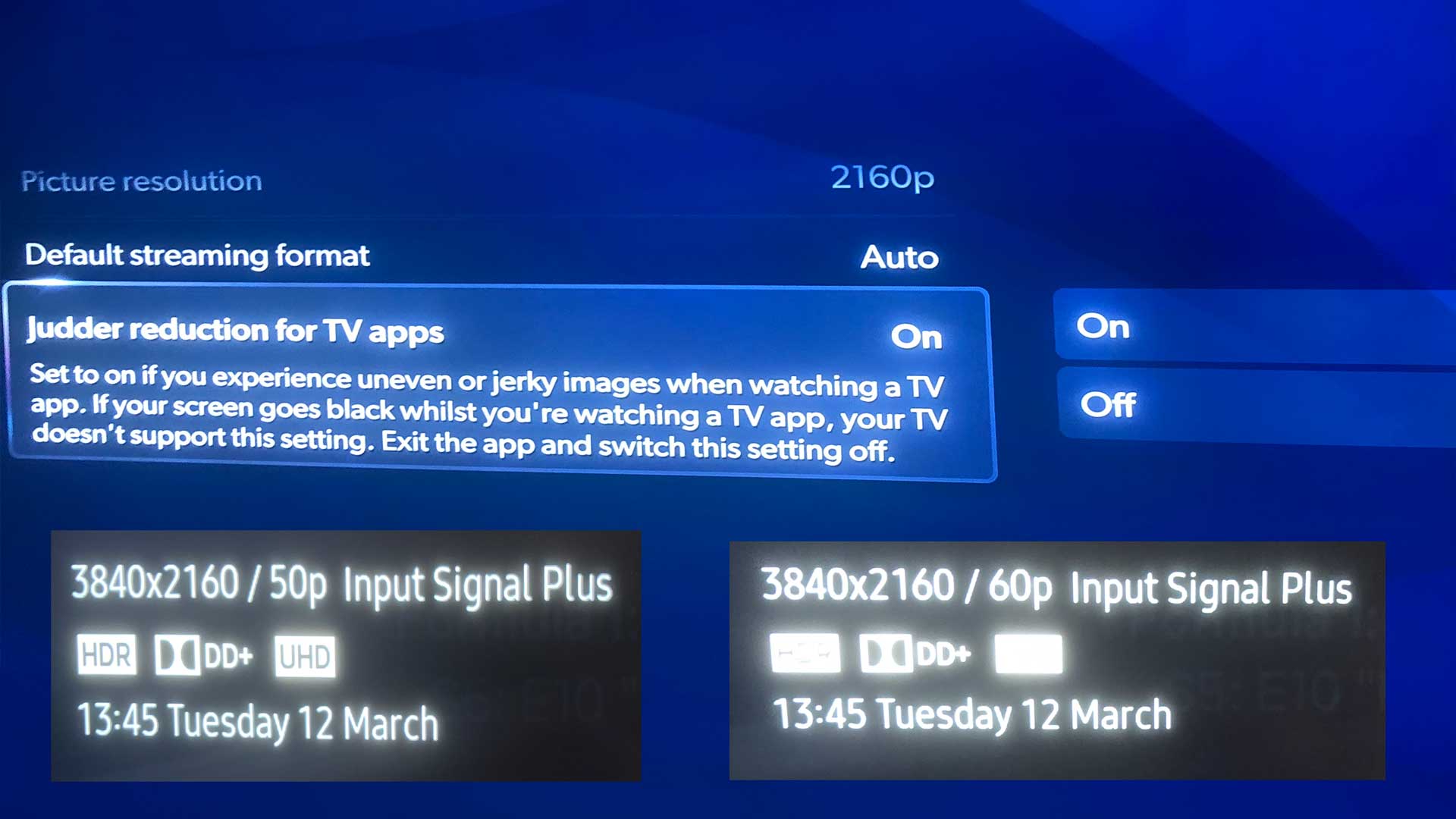
Happily there is a setting which says it will achieve “Judder reduction on TV apps” (see screenshot above). This was hopeful, especially as it warned about black screens appearing, which is the downside of frame-rate following, because of the frequent HDMI handshakes when things change, though it’s rarely a problem on modern TVs (some older projectors could take forever to handshake).
That judder setting turned out merely to lock the Hubbl puck to 60Hz instead of 50Hz (see insets on the image above). This does at least mean that any time you see judder you can at least try the other setting.
The level of judder may depend on your television. On that 8K Samsung, the wrong setting provided pronounced judder from frame-rate conversion. This left us changing manually for each programme. With this TV some key services also had intolerably long audio delay; some services and programming but not all, so that we originally here in this article blamed the Hubbl exclusively.
But we have since [this section updated 14 Mar] tried the Hubbl into a current Hisense 4K Mini LED TV, and there the delay vanished, while any judder was far better handled by the TV's processing (both were in film-maker mode, and others were tried).
Then with Hubbl plugged into a 2022 TCL Roku TV, the results fell somewhere between – significant sensitivity to judder under the wrong setting, and enough audio delay on some programming to distract. The Hubbl does have audio sync adjustment under settings, but only extending the audio lag, so making things worse rather than better.
All the Hubbl settings are rather buried, requiring you to scroll past 18 rows of show recommendations, many from services you’re not subscribed to. When watching free-to-air, there's remote access to settings for broadcast content – press the 'colours' button twice, then the 'right' on the central circle.
Once accustomed to the voice input from the remote control, we tried saying 'Go to settings', and that worked on the second attempt, so that's far faster than paging down 18 rows of the Home menu. The voice input also bypasses the Home menu, so the command 'Go to Netflix' returned us straight to the movie we'd been watching.
You can also your voice for Hubbl's useful universal search, which checks for content from a lot of services at once, including the ABC. Though not SBS, we think. Search ‘Oak Island’ and there are lots of hits for paid Binge Oak Island content, but not the free shows on SBS, except for a small tab at the bottom of one page under lots of Binge picture panels, saying 'Watch on SBS'. A search for ‘Australian Wars’ similarly brought up the series to watch on Binge, but entirely neglected to mention the same show is free on SBS.
But we have been informed that the search will keep an eye on the services you prefer to use, and learn to present those options first, so it should get more useful over time, ignoring services you don't have.
And certainly, when used with the voice input on the remote control, we were impressed with the search results. Click the mike button, say “Search Formula 1” (or F1), and the Hubbl returns a wealth of YouTubes, a mass of Kayo content of course, but also documentaries across Prime, Binge, 7plus – great stuff, both free and paid (if not the actual Netflix show we were looking for).
You can also add any how to the Hubbl's Watchlist using the '+' button on the remote, though Netflix doesn't quite work yet. It'll be a different watchlist from the ones you've already made on individual services, but like the search, it has the significant merit of being cross-platform.
Of course all the live TV comes for free; the tuner section opens up quickly, you get a guide (a button on the remote for this would have been nice), it’s loaded with the usual extra radio channels, and there are some great menu options for all sorts of subtitles and audio descriptions and even to mark a preference for surround sound, not that you’ll be getting any of that from terrestrial TV round here.
The problem with the live TV, of course, is that you can’t record it, and you can't pause it. Many TVs allow pausing if you leave a USB stick in the back, and we still find a video recorder incredibly useful – for one thing it’s the only remaining way to fast-forward through adverts. But here there’s only the option to turn up on time and watch a show live. Such 'event viewing' seems rather more pre-VHS 1970s than “the future of TV and streaming”, as the Hubbl headlines have it.
Foxtel's view is that pausing and recording is on the way out, so they haven't bothered worrying about it because everyone will be on the apps (and of course they have the usage stats to make that call). But surely anyone currently accustomed to pausing live TV or fast-forwarding ads will miss such functionality greatly.

Verdict
The Hubbl itself is nicely impulse-priced at $99; we love that it has a free-to-air tuner. But it is limited in various ways: no free-to-air recording or pausing, only a sub-set of streaming services, and the inability to follow source material frame rates, which may affect some users. Some of these could be fixed by future firmware, so we’ll leave it plugged up, and will report back here if it does.
As it stands, though, the Hubbl is hard to fully recommend, unless you’re just looking for a way to squirt your existing Binge and Kayo into a dumb TV in an extra room of the house. If you’re looking for a versatile media player we might go with Telstra in recommending instead a Fetch TV if you can afford the Mighty 4K with its hard drive, though it’s not comprehensive on apps either, partly because Streamotion has denied Kayo Sports and Binge to Fetch. Google sticks are often locked to 60Hz, so maybe an Apple TV, especially for iPhone and Mac users: currently models have frequency following, also Kayo Sports and Binge, though no Foxtel app. An Apple TV 4K may be more than twice the price of the Hubbl puck, but you can then have confidence in your frame rate, which many Sound+Image readers will consider a fundamental.

Jez is the Editor of Sound+Image magazine, having inhabited that role since 2006, more or less a lustrum after departing his UK homeland to adopt an additional nationality under the more favourable climes and skies of Australia. Prior to his desertion he was Editor of the UK's Stuff magazine, and before that Editor of What Hi-Fi? magazine, and before that of the erstwhile Audiophile magazine and of Electronics Today International. He makes music as well as enjoying it, is alarmingly wedded to the notion that Led Zeppelin remains the highest point of rock'n'roll yet attained, though remains willing to assess modern pretenders. He lives in a modest shack on Sydney's Northern Beaches with his Canadian wife Deanna, a rescue greyhound called Jewels, and an assortment of changing wildlife under care. If you're seeking his articles by clicking this profile, you'll see far more of them by switching to the Australian version of WHF.
